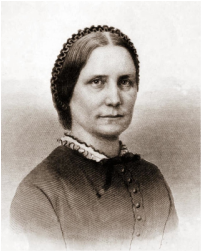
Recorded history overwhelmingly privileges men and affairs of state. It takes a special effort to unearth contributions of women who have long been relegated to the periphery of public life. This blog series will feature short biographies of remarkable, and largely forgotten, writers and reformers I discovered while working on Reliance, Illinois. It will also feature well-deserved shout-outs to historians and scholars who do the hard work of resurrecting the lives and legacies of these women. For how can women know themselves, or find their voices, without having known the voices and struggles of women who came before. Enjoy!
Mary Ashton Rice Livermore
I’m writing now from Chicago, so it’s fitting I begin with onetime Chicago resident Mary Livermore, one of the most fascinating and influential American women you’ve never heard of. Born in 1820 in Melrose, Massachusetts, Mary Livermore was a journalist, abolitionist and women’s rights advocate. During the Civil War she was co-director for the Northwestern branch of the United States Sanitary Commission and organized the Northwestern Sanitary Fair, raising no less than eighty-six thousand dollars for the Union effort (over twenty-million dollars today). After the Civil War she transferred her energies to the suffrage and women’s rights movements, founding the influential reform journal The Agitator, which merged with Woman’s Journal in 1872.
What fascinated me about Mary Livermore—apart from her delightfully opinionated books like What Shall We Do With Our Daughters? and Other Lectures—is how profoundly her attitude toward suffrage changed after joining the Sanitary Commission. While she had always worked for social reform alongside her husband, a Universalist minister, she was not, at first, committed to women’s suffrage. Her experiences organizing the Northwestern Sanitary Fair, and administrating what amounted to a national distribution system, supplying Union troops with food, medical supplies and other necessities, convinced her that women deserved a place in government, and that their active participation was necessary to achieve substantial reform. After the war she lectured widely, arguing for suffrage and for temperance; she appears in my novel (one of the few real historical figures to do so) on her way to one of these engagements.
But please do not consider my fictional portrayal an authentic portrait! Her cameo in my book is brief, and we learn of her through the decidedly biased eyes of Miss Rose. Livermore’s inclusion in the novel serves dramatic rather than biographical purpose. Her presence allowed me to dramatize the divide in the suffrage movement after the Civil War (and to heighten the tension in the novel between Miss Rose and Mrs. French). The long history of the women’s rights movement has never been one of peaceful unity. No diverse group of reformers, however committed, agree on how to approach reform, or even the kinds of reform necessary. The first wave of suffragettes were no different.
If you wish to learn more about Mary Livermore (I hope you do!) I heartily recommend Wendy Hamand Venet’s A Strong Minded Woman: The Life of Mary Livermore.
Next Post: Historian Wendy Hamand Venet
Click here to learn more about the divide in the suffrage movement after the Civil War
P.S.
I wrote the first post in this series at a beautiful little bookstore in Chicago, off Milwaukee Avenue, called Volumes Bookcafe. The store is brightly lit, stylishly appointed, with plush chairs, good sized tables, and a coffee bar to fuel the fits of inspiration that visits book people in such places. Sisters Kimberly and Rebecca George opened the store a little over two months ago and, judging from the steady stream of people though the door, the future is promising. It’s a beautiful space to read or work. I wandered in, bought a coffee and Viet Thanh Nguyen’s The Sympathizer, and settled in to write. If I’m in Chicago again, I’ll be sure to visit on purpose!
The store is on 1474 N Milwaukee Avenue in Chicago. Check it out! - MV

 RSS Feed
RSS Feed
